Read Reviews
The Best Cordless Strimmers for Allotments
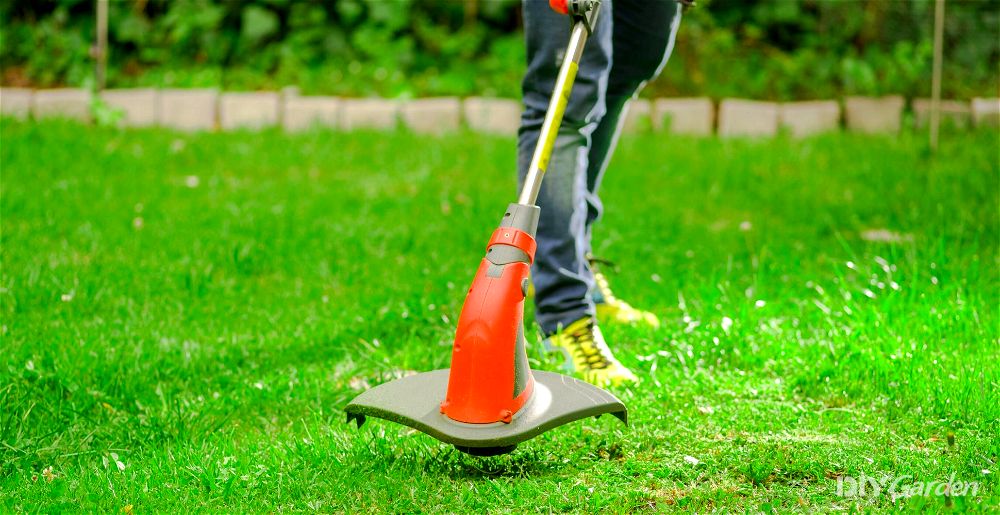
-
Ryobi OLT1832 ONE+ Cordless Grass Strimmer
-
WORX WG157E Cordless Grass Strimmer
-
Bosch Advanced Grass Cut 36 Cordless Strimmer
-
BLACK+DECKER 36V Cordless AFS Strimmer
-
Makita DUR181Z 18V String Trimmer
Cordless Strimmer for Allotments Reviews
- Lightweight and easy to manoeuvre
- Versatile cutting width can be adjusted from 25 - 30 cm
- Three adjustable head positions are useful for strimming around obstacles at different angles
- Easy to change between a trimmer and edging tool
- Compatible with batteries in Ryobi's ONE+ range
- Bare unit so battery and charger aren't included
- Lacks the power to strim long grass or heavy weeds
If you need to work around a lot of obstacles on the allotment, the Ryobi Cordless Grass Trimmer is good option to consider.
Its head has three adjustable positions, making it possible to strim at different angles around obstructions like fencing, polytunnels and cages. Also, unlike most strimmers, the Ryobi Cordless Grass Trimmer doesn’t have a set cutting width. The width can be adjusted from 25 – 30 cm depending on what’s most appropriate for the space.
Instead of using a separate edging tool, the head of the Ryobi strimmer can also be rotated to neaten edges either on the allotment or in the garden.
The above factors make it one of the best cordless strimmers for allotments with obstacles, where versatility will be key. Another aspect that makes this strimmer versatile is that it’s part of Ryobi’s ONE+ range; although it comes as a bare unit with no battery or charger, any of the Ryobi ONE+ batteries will fit. If you own other Ryobi tools, this will be a good value item to buy.
With a telescopic handle, it can be adjusted to users of different heights, and the D-ring handle is also adjustable, making it easier to find a comfortable working position. Rubber padding on both the main and auxiliary handle help with grip.
The cutting spool is an auto-feed line, so when the strimmer is switched on, new line is released.
Using the 30 cm cutting width will use more power than the 25 cm width, although customers report that the battery life is generally pretty good – a 4.0 Ah battery will last for around 40 minutes.
In terms of power, this strimmer is best suited to cutting grass rather than heavier brush and weeds. Once the grass is at a manageable length, this strimmer will be able to maintain it. As mentioned, it has a lot of features that can help cut around obstacles, and it’s also good value and easy to manage at 2.3 kg (without a battery).
Did you find this review helpful?
- Good price considering quality and battery comes included
- Lightweight and easy to support and manoeuvre as both a trimmer and edger
- Converts from a strimmer to an edger in a couple of seconds and works well at both
- Can tackle grass and some weeds/nettles
- Smaller cutting width is useful for getting into narrow areas
- Battery takes a long time to charge - up to 5 hours from empty to full
- Holding the power trigger can be tiring for the hand
- Relatively short battery run time of 15 - 20 minutes
- No telescopic shaft so it isn't possible to change the height
WORX have several different strimmers currently on the market, but the WG157E Cordless Grass Trimmer is one of their best budget models.
Considering its price, you might expect it to be a ‘bare’ model only – but a 2.0 Ah battery also comes included. It can also be used with any other interchangeable Worx 20 V batteries, which can help boost run time.
There are pros and cons to this strimmer, as you might expect with it being cheaper model. It’s powerful enough for edge neatening and strimming short grass, and can also be used to tackle weeds and nettles. However, the battery runs out relatively quickly in around 15 – 20 minutes. Because of this, it will probably be better suited to small/medium allotments over large ones.
The strimmer is robust despite being lightweight. At 3.1 kg it’s easy to support and manoeuvre. There is an option to change it from a strimmer to an edger, by moving the head, and it does both functions well. Although, it’s worth noting that the head can be a little stiff.
Unlike many of the pricier strimmers featured on this page, the WORX WG157E doesn’t have a telescopic shaft. It may not be quite as comfortable to use as other models, depending on your height.
It also has a relatively basic auxiliary handle, which is a moulded piece of plastic as opposed to the D-ring-style handle that’s present on many other models.
Overall, it’s a good option for neatening up small/medium areas, and it will be one of the best cordless strimmers for your allotment if you’re working on a budget. It has a relatively small 25 cm head, so won’t be the most efficient at covering large spaces, but it’s lightweight, easy to manoeuvre and good at tackling grass and weeds.
Did you find this review helpful?
- Compatible with 36 V batteries from other Bosch tools (interchangeable)
- Relatively long battery life of approximately 35 minutes
- Capable of cutting grass, nettles, docks and most weeds
- Semi-automatic line feed function releases more line each time you pull the trigger, meaning no need to check the cable as you’re strimming
- Heavy at around 4 kg (when 2.0 Ah battery is fitted) - harness required and needs to be bought separately
- May choke when strimming longer grass
- Semi-automatic line feed stops working once the battery is down to one bar - you’ll need to pull more line out manually
Sold as a bare tool, the Bosch Advanced Grass Cut 36 Cordless Strimmer has enough power to compete with petrol models, despite being a battery-powered machine.
Whilst it may not have quite the same brute strength as a petrol strimmer, the Bosch Advanced Grass Cut 36 can still make its way through brambles and docks and the majority of weeds. It has a 30 cm cutting head meaning a large area can be covered relatively quickly too.
Although no battery comes included, it is compatible with interchangeable 36 V Bosch batteries, and is therefore one of the best cordless strimmers for allotments if you already own Bosch tools. If you need to buy a battery as well, it’s a slightly more expensive strimmer than some others on the market, but if you already have compatible batteries, it can offer good value for money.
When using a 2.0 Ah battery, the strimmer can achieve approximately 35 minutes run time. Battery lights on the handle clearly indicate how much power remains, and once the battery indicator drops down to its last bar, the semi-automatic line feed will stop working.
In order not to waste battery power, this strimmer is fitted with a Bosch Syneon chip. This allows the machine to sense when more power is required (when cutting thicker areas) and when power can be conserved.
Although the Bosch Advanced Grass Cut 36 works well on a lot of thick vegetation, it can struggle in longer grass. Long grass has a tendency to wrap around the strimmer and can cause it to choke.
Like many of the strimmers featured on this page, this model has an adjustable telescopic shaft and secondary handle for supporting the machine. However, it is relatively heavy – weighing around 4 kg with a 2.0 Ah battery attached – and is best used with a harness to support the weight.
No harness comes included, but there are clips at least where one can be attached.
All things considered, this is clearly a powerful strimmer, but it does have a few shortcomings – particularly when it comes to cutting longer grass. It will be a good-value buy for those who already own compatible Bosch batteries, and also offers a reasonable run-time for working on the allotment as well.
Did you find this review helpful?
- Even on the 'eco' power setting, this strimmer can trim all grassed areas
- Using the 'turbo' setting it can cut weeds, nettles and some thistles
- Length and position of handle is adjustable and is suitable for users up to at least 6' tall
- Lightweight, well-balanced and easy to use accurately
- Fast charge time of one hour
- Edge-trimming function is harder to master and doesn't provide much of a guide
- When cutting thicker vegetation, may only have a run time of 15 minutes
BLACK+DECKER have a great reputation for creating quality tools, and their 36 V Cordless AFS Strimmer is no exception. With a fast-charging battery, excellent cutting power, and a reliable auto-feed line system, it’s one of the best cordless strimmer for allotments.
The 2.0 Ah battery has a run time of 15 – 20 minutes on turbo mode, and 30 minutes + on the eco setting. The majority of grass-cutting jobs can be completed using the eco mode, with turbo only being required to cut through thicker foliage like nettles and thistles.
It’s a very powerful machine that rarely falters when strimming, and the battery is quick to recharge in approximately one hour. Even if the allotment is particularly overgrown at the start of the season, this BLACK+DECKER strimmer will be capable of clearing it relatively quickly.
With a 30 cm cutting swathe, it doesn’t take long to clear larger areas but it’s still narrow enough to also help with tidying up areas where the lawn mower can’t reach.
There is an auto-feed line system (AFS) that works well to deliver new cutting line when required, and it doesn’t seem to use it up too quickly. It’s easy to thread new line, or replace the spool, when required.
In terms of comfort, this BLACK+DECKER strimmer is well balanced and simple to adjust. The length of the telescopic shaft can be altered and it’s comfortable for users up to at least 6’ tall. It weighs 3.5 kg, and the position of the secondary handle can also be altered to create the best working position.
Plus, if you need to cut edges, the head can be flipped to allow for trimming along borders. However, this function is a little more basic and takes patience to create a clean cut because there isn’t much of a guide.
Overall, this strimmer is a useful and powerful machine to use on the allotment, capable of clearing nearly all of the overgrown vegetation that you will encounter. Its battery is also interchangeable with other 36 V batteries from BLACK+DECKER tools.
Did you find this review helpful?
- Capable of cutting through grass, nettles and even young brambles
- Lightweight and well balanced makes it comfortable for use for the duration of the battery life
- Comes with strap included which distributes the weight of the machine well
- Button on the strimmer head makes it easy to adjust the cutting angle between standard/edge trimming
- Single line cable not as powerful as double line
- Battery and charger need to be purchased separately
- May struggle with thicker, longer grass
Designed to be lightweight, the Makita DUR181Z 18 V String Trimmer is a manageable and durable tool that’s suitable for grass edging as well as tackling weeds on the allotment.
It comes as a bare unit, meaning no battery or charger is supplied, but it can be used with compatible 18 V Makita batteries. With a 3.0 Ah battery in place, the strimmer weighs 3.1 kg, and it comes with a shoulder strap that effectively distributes the weight.
This makes it manageable to use, particularly when using a sweeping arc cutting motion over the area. It has a 26 cm cutting head, which is slightly smaller than some of the models on this list, but still sufficient for medium-to-large allotments.
The shaft is also adjustable, as well as the position of the secondary handle, so combined with the manageable weight these factors make it one of the best cordless strimmers for allotments in terms of comfort. It’s also quick to set up – ready to use almost immediately out of the box.
In terms of power, it’s best suited to general grass maintenance or cutting smaller patches of weeds/nettles. The motor is likely to struggle more in lots of thick or long grass; however, some customers have still reported being able to cut down young brambles using this strimmer.
There’s only a single cutting cord, rather than the double cord that is present in more powerful strimmers, so it’s not necessarily as well equipped to handle tough areas.
Nevertheless, if you already have Makita batteries and are looking for something that is lightweight and reliable, this is a great option to consider for the allotment. Although it may not cope with very overgrown spaces, once the grass is down to a reasonable length this tool will stay on top of the maintenance.
Did you find this review helpful?
How to Choose the Best Cordless Strimmer for your Allotment
Whether you’re struggling with overgrown grass, weeds or brambles on the allotment, investing in a cordless strimmer will be one of the best ways to keep it under control.
Of course, finding effective tools to work on the allotment can be tricky; you’re often forced to rely on battery-powered machines given that there aren’t any plugs nearby, and some of these can be a lot more reliable than others.
The following information will give you a better idea about how to choose the best cordless strimmer for allotments – taking into account the specific restrictions of the allotment as a working environment.
READ NEXT: The Ultimate Guide to Starting an Allotment
Things to Consider When Choosing Allotment Tools
It can be hard to find tools that are practical and convenient to use on the allotment because there are more limitations compared to just working in the garden. Here are a few things to bear in mind when choosing allotment tools:
Power Supply
Most allotments don’t have easy access to a mains plug, so using any mains-powered tool is generally out of the question. Although you could use a generator, it’s generally easier just to find an alternative and use either battery-powered or petrol-powered tools. You’ll find more info on the pros and cons of these tools in the next section.
Tool Weight
Allotments aren’t always positioned right next door. You might be lucky enough to have an allotment that can be accessed from your garden, but the likelihood is you’ll have to walk at least a little way to reach your plot.
Carrying heavy tools can get tiring fast, and this will be particularly true if your allotment is a block or two away from your house. You may even try to transport all of your equipment at once, and having several heavy tools will make this a lot harder.
For this reason, it can help to have lightweight battery-powered tools, as these can be a lot lighter than petrol alternatives.
Transportation
Although many people can access their allotment by foot, many people still need to get in the car to get to the allotment. In this case it’s important to think about the size of the tools you’ll be taking to the allotment, and whether they are sufficiently compact to fit in the backseat or boot.
You may even be able to cycle to your allotment, so having tools that can fit in a backpack or pannier/rack bag will be very useful.
Noise Pollution
A lot of people head to the allotment for a bit of relaxation and to disconnect from the outside world; therefore, it’s important to think about noise pollution when choosing tools to use there. Whilst it’s accepted that people will occasionally need to use a lawnmower or power tool, consistently using machines with loud engines is unlikely to be appreciated.
Generally speaking, petrol-powered machines are noisier than battery-powered models (and they also cause the air to smell of petrol fumes).
READ NEXT: The UK’s Best Strimmers
Battery-Powered Strimmers vs Petrol-Powered Strimmers
Both of these strimmers are technically ‘cordless’, and therefore possible to use on the allotment without a mains power supply; however, there are pros and cons to each type of machine.
Here we’ll take a more in-depth look at petrol-powered strimmers versus battery-powered strimmers, so you can see which will work better on your allotment:
Battery-Powered Strimmers
Nowadays, battery-powered tools are pretty powerful. Most strimmers can cope with grass, nettles and weeds. Some will even be able to tackle light brambles. However, it’s unlikely that a battery powered strimmer will stand up to the task of cutting larger plants with thick stems, tough brambles or heavy brush.
The benefits of a battery-powered strimmer are:
- They’re very lightweight. Unlike petrol strimmers, cordless battery powered strimmers are lightweight and easy to manage. They’ll be easier to carry to an allotment than a petrol machine, and easier to lift into the car if necessary too. Naturally, they’re also easier to hold for prolonged periods whilst working.
- Versatile and easy to use in small areas. Battery powered strimmers can be used to neaten up areas where mowers can’t reach, and they’re generally well balanced (with no heavy engine) so they’re easier to control.
- Limited maintenance or preparation required. Lithium-ion batteries will hold their charge well, so as long as the battery was charged some time after its last use, the strimmer will be ready to go straight away. No fuel or oil mixing required.
- Powerful enough to cope with grass, nettles and some thicker vegetation. Battery-powered strimmers will cope with the majority of vegetation that will be found on an allotment.
- Quiet to run (particularly compared to petrol machines). The motors of battery-powered strimmers are quieter than petrol engines. Battery strimmers generally run at around 80 dB, whereas petrol strimmers reach approximately 90 – 110 dB.
READ NEXT: The UK’s Best Cordless Strimmers
The potential drawbacks of a battery-powered strimmer are:
- Short battery life. Depending on the battery you’re using, a battery-powered strimmer can last anywhere from 15 – 40 minutes. Tougher tasks will drain the battery much faster, and recharging can take up to an hour which will disrupt your work. Cordless strimmers aren’t the best option for longer jobs.
- They aren’t suitable for very heavy-duty tasks. If you’ve got a lot of tough undergrowth to work through, you’re better off opting for a petrol-powered strimmer or brushcutter. If the area is very overgrown, it’s unlikely that a battery-powered strimmer will be up to the task.
Petrol-Powered Strimmers
Petrol-powered strimmers are heavy-duty machines. They’re also just generally quite heavy. For most general allotment maintenance, a petrol-powered strimmer will be more powerful than necessary. They’re useful for cutting through heavy brush, thick brambles and tough weeds.
READ NEXT: The Best Brush Cutters
The benefits of a petrol-powered strimmer are:
- Extremely powerful. You’ll be able to clear overgrown areas with thick vegetation.
- Achieves power without using electricity. If you think you might forget to charge a battery in advance, you might find it easier to have a petrol strimmer.
- Longer running time than battery-powered models before fuel runs out.
The potential drawbacks of a petrol-powered strimmer are:
- They tend to be a lot heavier than battery-powered machines. This can make them tiring to hold whilst working, and also difficult to transport to the allotment.
- They’re loud and emit fumes. This may not be popular with other allotment-goers and also isn’t good for the environment.
- May be more powerful than necessary. Unless you need to clear thick brush, you may find a petrol-powered machine unwieldy. Using one could end up being a waste of energy when you could have an easier time with a less powerful model.
Different Cutting Mechanisms
Strimmers either use cutting line, or cutting blades, to cut the grass/weeds. You can choose a model with either one or the other, depending on which will work best for you.
Cutting Line Strimmers
Strimmers that use a cutting line have either one or two lines of nylon string inside the strimmer head. They use centrifugal force to cut – the line is no good for cutting when it’s not moving, but it becomes stiff and blade-like when it spins.
When the line wears out, new line needs to be fed into the cutting head from the spool. On some strimmers, this process is done manually; however, the majority of strimmers replace the line either automatically, or semi-automatically.
The two most popular ways to distribute more line are ‘bump feed’ and ‘automatic feed’.
A ‘bump feed’ strimmer requires you to ‘bump’ the head on the ground to release more line. With this method, you’re in control of when to release more line, and can control how quickly it is used.
‘Automatic feed’ strimmers tend to release new line each time the machine is turned on. There are pros and cons to this. It can ensure that you’re never using weak line; however, it can occasionally result in using line too fast. This can become costly.
If you’re using a battery-powered strimmer, you’ll naturally want to keep turning it off to save battery whilst moving about the allotment. This may waste line though, if it is automatically released each time you turn the unit on.
There’s also a choice of ‘single-line’ or ‘double-line’ strimmers. Single-line strimmers have less cutting force compared to double-line strimmers, but this isn’t always bad – you may want less force depending on the job. Some gardeners feel that grass strimmers with a double cutting line are too powerful. Their force may damage tree trunks, fencing or netting if you get too close.
Bladed Strimmers
Bladed strimmers generally use nylon blades which attach to the head of the strimmer and spin at speed. These spinning blades generate a lot of cutting power.
Generally speaking, blades will need to be replaced after two hours of use. They often get damaged whilst cutting, and occasionally will spin off and end up lost in the undergrowth.
Replacement blades are easy to come by. Packs of approximately 30 blades can be found online for about £10.
In terms of cutting power, blades are often considered slightly stronger than cutting line. You should be careful using blades around trees, rocks, and other hard surfaces as they can cause damage. Some gardeners prefer blades because they don’t have to mess around with cutting line, whilst others don’t like needing to frequently replace the blades.
READ NEXT: The Best Allotment Polytunnels
Cordless Strimmer FAQs
Cordless strimmers will last for approximately 15 – 45 minutes depending on what battery you are using and what vegetation you are cutting. Batteries with less power (such as 2.0 Ah batteries) will generally last around 20 minutes. More powerful batteries (such as 4.0 Ah batteries) can last closer to 40 minutes.
If you are forcing the strimmer through heavy vegetation, the battery will run down faster.
The charging time will depend on the charger. Some strimmers come with quick chargers that will charge the battery in approximately 1 hour; however, others may take up to 5 hours to complete charging.
If you want to clear a large area of unkempt grass and weeds, a strimmer of approximately 20 V will be sufficient. In many cases, an 18 V strimmer will manage, but it might struggle more on thick grass.
Petrol strimmers are usually too powerful for small jobs like edging lawns or cutting back smaller patches of weeds. Petrol strimmers are better suited to cutting back thick brush and brambles.
Wear protective clothing such as ear defenders, particularly if the job is going to take a while. Even electric motors can be very loud.
Sturdy boots are also a must, in order to protect your feet, and you should avoid wearing loose clothing that could get caught in the strimmer.
For overgrown areas, opt for protective glasses. Strimming can throw up stones and other sharp objects which can get in your eye if you’re not careful.
Finally, wear a pair of gloves to protect your hands while strimming. If your strimmer vibrates a lot, you should take frequent breaks.
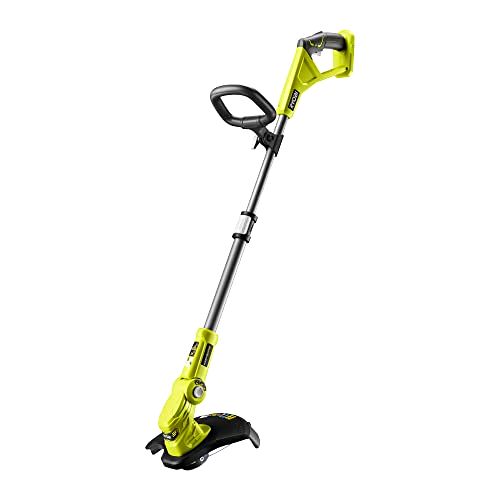
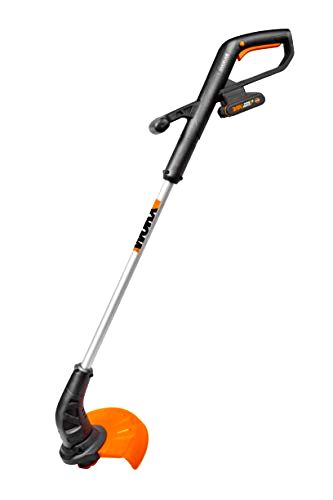
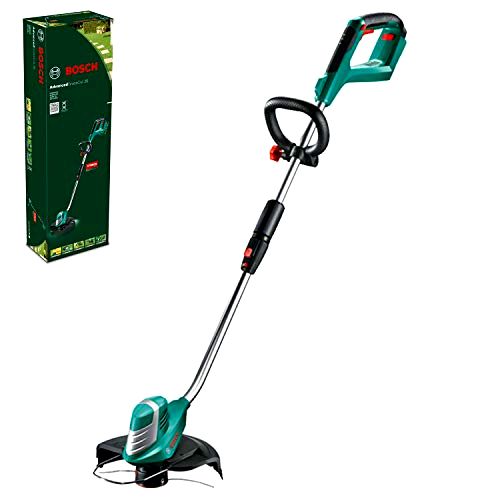
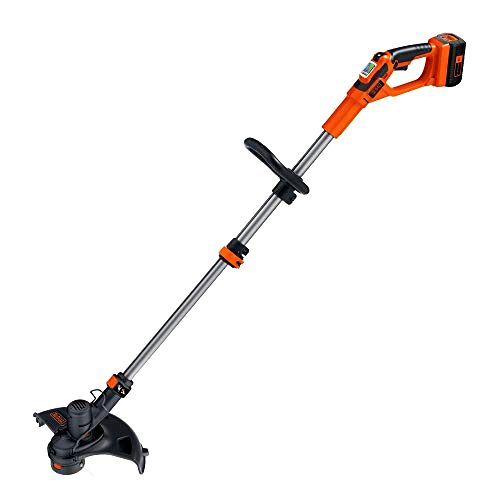
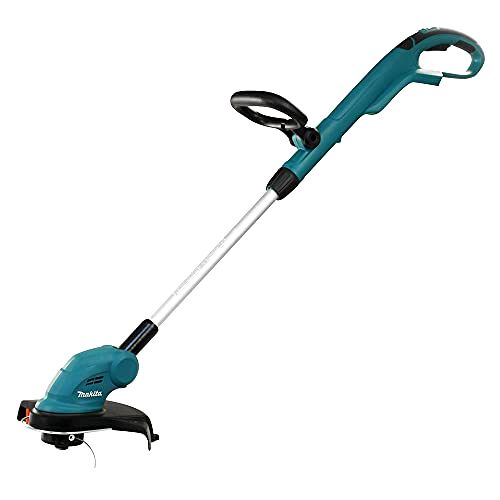

Share